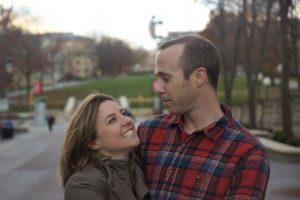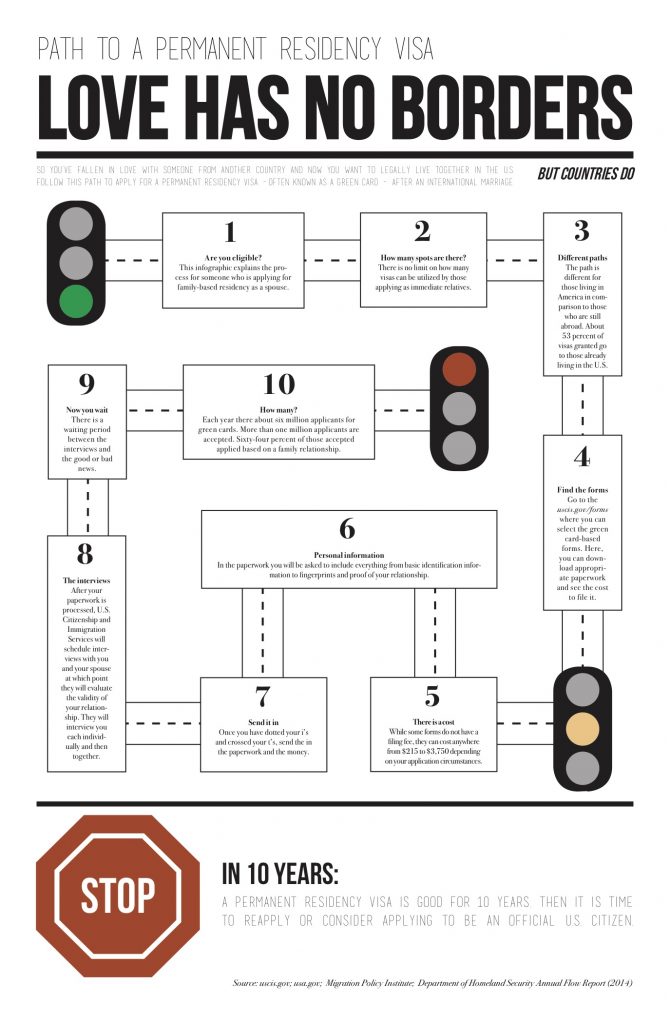Most college couples worry about what time they can meet each other after class and whether or not to have a sleepover on a school night. Eva Bernstein and Jacob Faber instead are preoccupied with planning weekend trips between Madison and Vancouver, which involve 12 hours of travel time for each 36-hour visit.
They started dating when they were volunteering during a gap year in Israel between high school and college. For the first three months of their relationship, they were next-door neighbors, but eventually their program separated into two cities. They were then a two-hour train ride away from each other.

“I guess that was the first little bit of distance that we had, even though it was only two hours,” Eva says about their first experience apart. “I would say that was definitely a really good indication of how our communication would be.”
After the program ended, however, the real test began: Just nine months after they started dating, they parted ways to go to college. He went to the University of British Columbia, where he studies electrical engineering 2,000 miles away from her at UW-Madison, where she is pre-med.
Now three years after they met in Israel, the two have developed a system for navigating their international relationship. They visit one another every semester, and alternate spending the summers working at camps in each other’s home countries.
“We can’t just text, ‘Oh hey, what are you doing, do you want to hang out?’ You have to buy a plane ticket in advance, and find a weekend where we both don’t have something big, and then money,” Eva says about planning time to be with each other. “We have to be deliberate and really forward-thinking about how to plan.”
International relationships like this one are not entirely uncommon in America. About 7 percent of married couples include a foreign-born spouse, according to the U.S. Census Bureau. What’s more, in the past four decades there has also been an increase in multicultural marriages — in regards to race, ethnicity and religion.
For couples who cross borders, there are higher stakes. Often this means at least one person leaving their family and friends, applying for visas and citizenship, and booking expensive tickets for commuting back and forth. Many couples endure long distance for a long time before they can legally be together, and time differences make communication messy. But for those who make these cross-cultural relationships work, their love is able to transcend the borders that countries create.
“People love to be like, ‘Long-distance is impossible, it will always end and stuff.’ But I really don’t believe that,” Eva says. “You make it work if you love that person and you want to be with them.”
Lauren Blume cried in front of the check-in agent at a New Zealand airport. Her bags were too heavy and she was being hassled to repack, but that wasn’t the reason for her tears. She was leaving the country early and had just said a painful goodbye to her then-boyfriend of three years and now-husband, Richard Saunders, who she thought she might never see again.
“I was extremely upset, I was bawling,” Lauren says, describing the day like a scene from a movie. “It’s kind of funny now, but it was not funny at the time.”
Lauren was supposed to have a few months in New Zealand after finishing veterinary school at Massey University before starting an internship at a clinic in Chicago. Then her grandfather passed away, giving her one week to get home for the funeral.
There was hardly time to pack and get a ticket, nonetheless think about what would happen to her relationship once she left. Richard and Lauren didn’t know when they would see each other again, but they knew they could try to make it work.
“We talked about it; we knew there was uncertainty,” Richard says. “We knew that things might not work out, but I was fairly optimistic that if we wanted to stay together, we’d stay together.”
They were working with a 17-hour time difference and Lauren’s chaotic schedule. The first year of training is the hardest for a veterinarian, and she sometimes worked 20 hours a day, seven days a week. Meanwhile, Richard was working as an asset management consultant, where he had a lot more flexibility, but still a busy workload. They didn’t talk every day, but they Skyped when they could.
“It really helped that I was so busy, because I had so much to take my mind off of things,” Lauren says. “Even though, yes, it was sad, and we wished we were together, I think we made the most of it and it was just getting through that one tough year.”
Because of her difficult work schedule, Lauren was unable to make a trip back to New Zealand. So Richard came to her. In the year that they were apart, he spent about $5,000 on plane tickets. Though she knew he was coming, it still felt like a surprise to Lauren on both of his two-week visits.

“It’s hard to imagine that someone would fly around the world to come see you,” Lauren says, explaining how amazed she was. “It’s a long ways, and it’s a lot of money.”
Richard’s plan was to join Lauren in the U.S. once she found a long-term job. So when Lauren was accepted for a four-year residency at a UW-Madison clinic, he followed her there. Then on the first day of 2016, Richard and Lauren walked to Picnic Point, where he would get down on one snowy knee, and she would say yes.
With Lauren’s family sprinkled in states across the country and Richard’s family in both New Zealand and Australia, they knew planning a wedding including everyone would be both a headache to coordinate and a fortune to put together. Instead, they decided to keep the wedding intimate. Only the officiant, elopement coordinator and photographer attended Richard and Lauren’s ceremony on a sandy beach in Hawaii last May, and for them, that was perfect.
Rána Roman and Dylan Gordon were supposed to honeymoon for 10 days on the Greek island of Santorini, but they ended up in Las Vegas instead.
They didn’t realize until 10 days before the wedding that Dylan’s South African passport would not be accepted for valid entry to Greece. It was too late to start the paperwork, so instead they chose a new destination: viva Las Vegas.
After the honeymoon they went back to long distance. Rána stayed in a downtown Milwaukee apartment to be near family, and Dylan served out his final contract as a store manager on a Royal Caribbean cruise ship. They had met on a similar ship when Rána was a singer in the nightly shows. This would be their fifth year of short visits every three months, emails and scheduled phone calls.
When Dylan finished his year on board, the company flew him back to Cape Town, where he would say goodbye to his friends, family and home. He packed all of his belongings into two suitcases and moved to America. Dylan has not been back to South Africa in over 10 years — Wisconsin is his home now.
“When I got to the U.S. for the final time, I had two full-size suitcases of everything I owned that was important to me at the time,” Dylan says, adding, “I didn’t have a sofa.”

In order for Wisconsin to be his home, however, Dylan had to apply for his permanent residency visa — often referred to as a green card. The process started when he was in South Africa, where the U.S. consulate evaluated if he was a flight risk for overstaying his visa. Then, from Milwaukee, Dylan filled out the paperwork. This included personal history, fingerprints and even proof of Rána and Dylan’s relationship — a preliminary measure to check if they were really in love or if this was a marriage for citizenship.
“That was a lot of money, a lot of hoops, a lot of interviews, a lot of crying from Rána,” Dylan says about the application, “And there’s no guarantee that you’re going to be approved.”
After dotting the i’s and crossing the t’s, Dylan sent in the forms along with multiple bank-guaranteed checks for a total of about $1,400. Next they scheduled an appointment for the interviews.
“I cannot shake your hand, that means I have created a bond with you, I will not shake your hand,” Dylan recalls the interviewer saying when he extended his hand before their final interviews. She first interviewed Dylan alone, then Rána, and then they finished their evaluation with an interview together.
“It was very formal, very abrupt; it wasn’t a comforting feeling. We didn’t leave feeling like yes, we had proven to this lady how much we love each other,” Dylan says. “We left thinking, ‘Well, this is up to her now.’”
When the process was over and they had made their case, the only thing left to do was wait. They spent the following day reassuring each other that everything would be okay, despite the uncertainty after the in-person evaluations.
“At that point Rána looked at me and she said ‘Baby, if they deny you I will go home with you,’” Dylan says, remembering how tense they felt after the interviews.
Rána and Dylan’s story has a happy ending: the next night he received an email welcoming him to America. But each year about 6 million people apply for permanent residency and only about 1 million are accepted, according to the American Immigration Center.
“We were unbelievably fortunate with the circumstances under which we started this process,” Rána says. “Just going abroad and meeting somebody and falling in love and wanting to make a life together … it’s not that easy. And partly because it’s expensive.”
Despite being married for 22 years, Sheri and Katsuya Sato are not citizens in each other’s home countries. In fact, most times they don’t even live on the same continent, though they do visit each other every two to three months. Katsuya lives in a small farm town in Japan, while Sheri stays in Appleton, where the two met nearly 30 years ago.
Sheri tried living in Japan. She moved to be with him not knowing any Japanese. But it was extremely rare for a Japanese man to bring home an American woman, and for a long time they weren’t accepted as a couple, even in their own home. They had to beg for permission from Katsuya’s mother, father and the neighborhood, even going door to door, getting on their knees to ask for approval from the neighbors.
“You can’t think too hard about it, because there are rules in every culture, but just because it’s a rule in your culture doesn’t mean it’s a rule in your personal life,” Sheri says, “If we lived by rules in my husband’s culture, we would totally be done and over.”
Sheri taught English in Tokyo for one year before moving to the city of Morioka to be closer to Katsuya. After they were married in Appleton in 1994, they immediately moved in with Katsuya’s parents in Ninohe, Japan. But over time, the cultural differences became too much for Sheri.

Since Katsuya is the only son in his family, it was customary for him to take over the family business, which in the Sato case is a pig-farming company. And since Sheri is his wife, it was her duty to manage the household responsibilities, including cooking, cleaning, laundry and other chores. This wasn’t just for her immediate family of six, but for Katsuya’s parents, siblings and their children. At one point, there were nine kids in the house.
“It’s hard, I’m not Japanese. I love Japan, I love it to death, but that’s not me,” Sheri says.
Though all four of the children were born in Japan, Sheri and Katsuya ended up raising their children from both countries. Sheri and the kids would alternate every six months living in the two countries, while Katsuya stayed in Japan to run the business.
As a result, the kids speak fluent Japanese and English and also have dual citizenship. “I know that the kids in my family are very loved, by both my husband and myself,” she says. It makes her happy to see how well they have taken to both cultures.
While at times when they talk the distance seems unbearable, to Sheri the back-and-forth lifestyle keeps her life and relationship exciting. She looks forward to visiting Japan and to times when Katsuya makes his way to Appleton.
“I’m very happy. And I have totally no regret,” Sheri says. “I have probably the best person in the world for myself.”
Allison Garcia
 Allison is obsessed with Rick Steves. As the daughter of a flight attendant, she often plans one-day European adventures based soley on his sage advice. While currently completing her senior year and working at the Wisconsin State Journal, she has dreams of writing travel news for a publication or doing public relations for one of America’s national parks.
Allison is obsessed with Rick Steves. As the daughter of a flight attendant, she often plans one-day European adventures based soley on his sage advice. While currently completing her senior year and working at the Wisconsin State Journal, she has dreams of writing travel news for a publication or doing public relations for one of America’s national parks.

